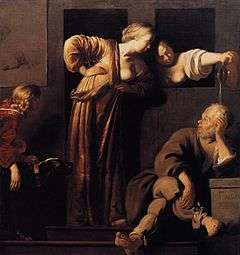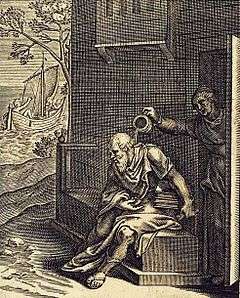Xanthippe

Xanthippe (/zænˈθɪpi/; Greek: Ξανθίππη, Greek pronunciation: [kʰsantʰíp̚pɛ͜ɛ]; 5th century – 4th century BCE) was an ancient Athenian, the wife of Socrates and mother of their three sons: Lamprocles, Sophroniscus, and Menexenus. She was likely much younger than Socrates, perhaps by as much as 40 years.[1]
Name
Xanthippe means "yellow horse", from the Greek ξανθός xanthos (blonde) and ἵππος hippos (horse). Hers is one of many Greek personal names with a horse theme (cf. Philippos "friend of horses", Hippocrates "horse tamer" etc.). The hippos in an ancient Greek name often suggested aristocratic heritage.[2] One additional reason for thinking Xanthippe's family was socially prominent was that her eldest son was named Lamprocles instead of "Sophroniscus" (after Socrates' father): the ancient Greek custom was to name one's first child after the more illustrious of the two grandfathers. Xanthippe's father is believed to have been named Lamprocles. Since he was even more well-established in Athenian aristocracy than was Socrates' father, his name would have been the preferred choice for the name of the first-born son.[3]
Character

Plato's portrayal of Xanthippe in the Phaedo suggests that she was a devoted wife and mother;[4] She is mentioned nowhere else in Plato.[5] Xenophon, in his Memorabilia, portrays her in much the same light, although he does make Lamprocles complain of her harshness;[6] it could be argued that this is fairly typical of an adolescent's views of a strict parent. It is only in Xenophon's Symposium where we have Socrates agree that she is (in Antisthenes' words) "the hardest to get along with of all the women there are."[7] Nevertheless, Socrates adds that he chose her precisely because of her argumentative spirit:
It is the example of the rider who wishes to become an expert horseman: "None of your soft-mouthed, docile animals for me," he says; "the horse for me to own must show some spirit" in the belief, no doubt, if he can manage such an animal, it will be easy enough to deal with every other horse besides. And that is just my case. I wish to deal with human beings, to associate with man in general; hence my choice of wife. I know full well, if I can tolerate her spirit, I can with ease attach myself to every human being else.[8]
Perhaps this picture of Xanthippe originated with the historical Antisthenes, one of Socrates' pupils, since Xenophon initially puts this view into his mouth. Aelian also depicts her as a jealous shrew in his description of an episode in which she tramples underfoot a large and beautiful cake sent to Socrates by Alcibiades.[9] Diogenes Laërtius tells of other stories involving Xanthippe's supposed abusiveness, but he does not cite any source for them.[10]

It seems that Xenophon's portrayal of her in his Symposium has been the most influential: Diogenes Laërtius, for example, seems to quote the Symposium passage, though he does not mention Xenophon by name,[10] and the term "Xanthippe" has now come to mean any nagging scolding person, especially a shrewish wife.
Later writers, such as Diogenes Laërtius who cite Aristotle as the earliest source, say that Socrates had a second wife called Myrto.[10] Plutarch tells of a similar story, reporting that it comes from a work entitled On Good Birth, but he expresses doubt as to whether it was written by Aristotle.[11] In Plutarch's version of the story, Socrates, who was already married, attended to Myrto's financial concerns when she became a widow; this does not entail marriage. We have no more reliable evidence on this issue.[12]
An unconfirmed anecdote purports that once Xanthippe was so enraged with her husband, that she took a chamber pot and poured it out over Socrates' head, which – goes the tale on – the philosopher accepted with the allegory: “After thunder comes the rain.”
Literary references
In Shakespeare's Taming of the Shrew, Petruchio compares Katherina "As Socrates' Xanthippe or a worse" in Act 1 Scene 2. (Read here)
Addison discusses matrimony in The Spectator no.482, dated Friday 12 September 1712:
| “ | An honest Tradesman, who dates his Letter from Cheapside, sends me Thanks in the name of a Club, who, he tells me, meet as often as their Wives will give them leave, and stay together till they are sent for home. He informs me, that my Paper has administered great Consolation to their whole Club, and desires me to give some further Account of Socrates, and to acquaint them in whose Reign he lived, whether he was a Citizen or a Courtier, whether he buried Xantippe | ” |
The novelist Henry Fielding describes the shrewish Mrs. Partridge thus:
| “ | She was, besides, a profest follower of that noble sect founded by Xantippe of old; by means of which she became more formidable in the school than her husband; for, to confess the truth, he was never master there, or anywhere else, in her presence.
... for she continued longer in a state of affability, after this fit of jealousy was ended, than her husband had ever known before: and, had it not been for some little exercises, which all the followers of Xantippe are obliged to perform daily, Mr Partridge would have enjoyed a perfect serenity of several months. |
” |
- The History of Tom Jones, a Foundling, Book II, Chapters iii & iv.
The English Victorian poet Amy Levy wrote a dramatic monologue called "Xantippe".[13]
In his poem 'An Acrostic', Edgar Allan Poe makes references to her although he allegedly purposely misspells her name and instead writes 'Zantippe'.
In "Doctor Thorne" by Anthony Trollope the author says of wives 'There may possibly have been a Xantippe here and there, but Imogenes are to be found under every bush.'
Solomon Maimon refers to a woman's "Xanthippe-like character" in Chapter 10 of his autobiography. ("A widow, celebrated for her superior talents, as well as for her Xanthippe-like character, kept a public house at the extremity of one of the suburbs. She had a daughter who yielded to her in none of the above-mentioned qualities, and who was indispensable to her in the management of the house. [...]"
James Joyce in episode 9 of Ulysses,Scylla and Charybdis, has John Eglinton ask Stephen Dedalus″What useful discovery did Socrates learn from Xanthippe?″[14]
In popular culture
Xanthippe has a fairly important role in Maxwell Anderson's 1951 play Barefoot in Athens. In the 1966 Hallmark Hall of Fame television production, she was played by Geraldine Page opposite Peter Ustinov as Socrates.
In the 1953 young-adult detective novel Detectives in Togas (1953) by Henry Winterfeld, the schoolboys often joke about their schoolmaster Xanthos, saying his name reminds them of Xanthippe.
"Puttermesser and Xanthippe" is the title of one of the chapters of American novelist Cynthia Ozick's 1997 novel The Puttermesser Papers, a National Book Award finalist. In Cynthia Ozick's 1997 novel, The Puttermesser Papers, Ruth Puttermesser creates a golem who insists on being called Xanthippe.
A fictional account of Xanthippe's relationship with her husband is presented in the play Xanthippe by the British author and playwright Deborah Freeman. Xanthippe was first produced at the Brockley Jack Theatre, London, in 1999.
A rebellious, dramatic, female teen is named "Xanthippe" in the Netflix comedy Unbreakable Kimmy Schmidt which first aired on Netflix in 2015.
Emanuel Carnevali, Italian-American poet, in his Autobiography refers to women he meets while being treated for encephalitis in an Italian sanatorium as "Xanthippes all."
Scientific references
Asteroid 156 Xanthippe is named in her honour.
In 1995, P. Naskrecki and R. K. Colwell[15] gave the name Xanthippe to a new genus of flower mite that inhabits flowers of palms of the genus Socratea and is probably phoretic on the beetles that pollinate the palm.
A species of African white-toothed shrew was described by Wilfred Hudson Osgood in 1910 as Crocidura xantippe, common name "Xanthippe's Shrew."
See also
References
- ↑ She must have been young enough to give birth to their three children Plato describes in his writings: In the Apology 34d, the sons are described as quite young: two of them "children", the other a "lad"; in Plato's Phaedo 60a, one of them is small enough to be held in his mother's arms. Both dialogues take place when Socrates is supposed to have been 70 years old. Also Mario's boat name
- ↑ Aristophanes, Clouds 60-64. Xanthippus, e.g., was the father of Pericles. Also, hippeis, literally "horsemen" or "knights", was the name of one of the highest socio-economic classes of Athens.
- ↑ John Burnet 1911, Plato: Phaedo, p. 12.
- ↑ Plato. Phaedo, 60a-b, 116b
- ↑ Xanthippe does receive mention in two short, apocryphal pieces within the literature ascribed traditionally to Plato but considered generally by scholars to be inauthentic. These come in the Halcyon and the Epigrams.
- ↑ Xenophon, Memorabilia, 2.2.7-9
- ↑ Xenophon, Symposium, 2.10
- ↑ Xenophon, Symposium 17-19 [= 2.10]
- ↑ Aelian, Varia Hist. XI.12
- 1 2 3 Diogenes Laërtius 2.36-37
- ↑ Plutarch, Aristides xxvii. 3-4
- ↑ For the relevant quotes from Diogenes and Plutarch, see The Complete Works of Aristotle, edited by Jonathan Barnes, vol. 2, p. 2423.
- ↑ "Xantippe, and Other Verse.". indiana.edu.
- ↑ Ulysses, James Joyce,p.170. Wordsworth Classics edition ,2010. Ulysses annotated. Notes for James Joyce's Ulysses, Don Gifford with Robert J Seidman, Revised and Expanded edition, University of California Press, 1988.
- ↑ Naskrecki, P. and R. K. Colwell. 1995. A new genus and two new species of Melicharini from Venezuela (Acari: Mesostigmata: Ascidae). Annals of the Entomological Society of America 88:284-293.